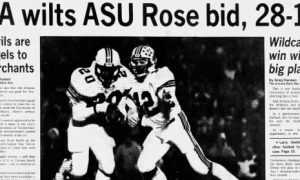
The 1914 Arizona football team to earn the honor of being named the first “Wildcats” was composed of (front row, left to right): Verne La Tourette, George Seeley, Leo Cloud, Richard Meyer, Asa Porter. Second row: Franklin Luis, Lawrence Jackson, Ray Miller, J.F. “Pop” McKale (coach), Turner Smith, Harry Hobson (manager), Orville McPherson, Albert Crawford, Ernest Renaud. Back row: Albert Condron, Emzy Lynch, Charley Beach, Vinton Hammels, Bill Hendry, George Clawson, Harry Turvey.
(AllSportsTucson.com graphic/Photo from University of Arizona Library Special Collections)
Excerpt from Los Angeles Times, Nov. 8, 1914, authored by Bill Henry:
“Arizona’s cactus-fed athletes, despite heroic efforts on the part of their two halfbacks, (Asa) Porter and (Franklin) Luis, went down to defeat before the Occidental Tigers yesterday afternoon, the tally with all precincts heard from being 14 to 0 in favor of the Tigers.
Confident of rolling up a big score, the Tigers took the field with grins on their faces, but before the game was 10 seconds old they knew they had a battle on their hands.
The Arizona men showed the fight of wild cats and displayed before the public gaze a couple of little shrimps in the backfield who defied all attempts of the Tigers to stop them.”
This site will conduct a countdown over the next 100 days, leading up to Arizona’s 2014 football season-opener with UNLV on Aug. 29 at Arizona Stadium. The 100 Days ‘Til Kickoff countdown will include information daily about the historic 1914 Arizona team that helped create the school’s nickname of “Wildcats” because of how they played that fateful day against Occidental.

James Fred “Pop” McKale began his legendary coaching and administrative career at Arizona 100 years ago.
Arizona was only two years into statehood in 1914 when first-year coach J.F. “Pop” McKale and the University of Arizona “Varsity” football team took a train ride to Los Angeles to play the mighty Occidental Tigers.
Tucson’s population in 1914 (approximately 15,004, according to the United States Bureau of the Census) was almost equal to the capacity of today’s McKale Center (14,545). The Tucson Country Club, the city’s first golf course, opened in 1914 as a 9-hole layout with dirt as the terrain. Grass was not added until 1929.
Other than around the university, established less than 30 years previously in 1885, Tucson’s bustling scene was the Stone Avenue and Pennington Street intersection and nearby Congress Street area downtown. Transportation included an electric streetcar system that replaced the horse- and mule-drawn carriages in 1906.
The speed limit was only 10 miles per hour for the few automobiles that occupied the dirt roads in the small desert town.
Cacti outnumbered folks in the region, hence Bill Henry’s description of Arizona as “cactus-fed athletes” in the Los Angeles Times report. Henry also references Arizona — whose nickname was “Varsity” — as the “Prohibitionists” a couple of times in the game story.

Bill Henry, a longtime Los Angeles Times reporter and columnist, was honored by the University of Arizona in 1964 as the “Father of the Wildcats” for his report in 1914 that suggested Arizona played Occidental College with the “fight of wild cats”. The UA’s nickname officially became Wildcats the following season.
“Porter at left half and Luis at right half for Arizona carried the ball, it is safe to say at least nine times out of every 10, and if the Prohibitionists had possessed one other man who could carry the ball sufficiently well to give these two little giants a chance to rest, the score might have been different,” writes Henry, who graduated from Occidental in the previous school year.
Prohibitionists was Henry’s way of describing McKale’s team as a unit that refused to give in to Occidental’s superior talent. Henry’s use of “wild cats” had a much better ring. Those two words combined into one — Wildcats — officially became the school’s nickname the following school year. Almost 100 years later, the Wildcats moniker lives on.
“Porter at left half and Luis at right half for Arizona carried the ball, it is safe to say at least nine times out of every 10, and if the Prohibitionists had possessed one other man who could carry the ball sufficiently well to give these two little giants a chance to rest, the score might have been different.”
— Los Angeles Times correspondent Bill Henry
From a historical perspective, the 14-0 loss to Occidental, the defending California champion, on Nov. 7, 1914, is one of Arizona’s most significant games. The game was a loss, but the “Varsity” demonstrated, in only the 16th year of the program’s existence, that a competitive team from Tucson can take the field.
Members of the Arizona student body read Henry’s report and became enthused over the idea of “Wildcats” becoming the school’s nickname. After sticking with “Varsity” as the nickname in the following game against New Mexico State, Arizona unofficially became the “Wildcats” in the season-finale against Pomona College. By the end of 1914-15 school year, the majority of the 308 students enrolled at the university voted in favor of the change.
The game against Pomona, a 7-6 victory on Thanksgiving Day, was also Arizona’s first homecoming game. The game was played in front of approximately 600 fans, which according to the Tucson Daily Citizen, was the largest crowd to gather at the field near Old Main.
The victory capped a 4-1 season in McKale’s debut at the university. McKale, a 27-year-old budding coach and administrator from Lansing, Mich., served as the coach of the football and basketball teams and the athletic director starting in 1914. He coached basketball until 1921 and football until 1930. He was athletic director for 43 years. He also coached baseball in two different stints (1915-1919 and 1922-1949).
The late Henry, who later became a renowned Los Angeles Times columnist and war correspondent, was honored as the “Father of the Arizona Wildcats” at the 50th homecoming anniversary in 1964. The game against Idaho was played 50 years to the exact date (Nov. 7) when the “Varsity” played Occidental.
Arizona’s centennial homecoming celebration this season is scheduled against Colorado on Nov. 8, the same date 100 years previously in which Henry’s “they fought like wild cats” article was published in the Times.
Arizona’s 1914 team was inducted into the Arizona Sports Hall of Fame in 1996, becoming the only non-national championship team to earn such an honor.
Another historical fact about the 1914 team: Arizona’s victory over Pomona led to the building of the “A” on Sentinel Peak, west of Tucson.
According to the university, Albert Condron, a member of the 1914 team and a civil engineering student, suggested to one of his professors after the rousing victory over Pomona that a class assignment be made to survey Sentinel Peak for the location of an “A”.
The site was cleared of shrubbery and cactus, and trenches were dug to outline the letter’s foundation. The project was complete by 1916. “A” Mountain was born.
ALLSPORTSTUCSON.com publisher, writer and editor Javier Morales is a former Arizona Press Club award winner. He also writes articles for Bleacher Report and Lindy’s College Sports.
[rps-paypal]
|
|





























